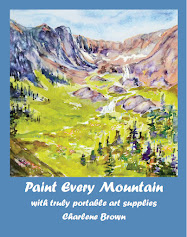Melting glaciers and thawing permafrost on Bylot
Island NU
watercolour and crayon
©2025
Charlene Brown
As the Arctic warms faster than any region
on Earth, attention has largely been focused on the rapid disappearance of
Arctic sea ice. But major changes are also taking place on land, and one of the
most striking is the thawing of vast swaths of permafrost, the frozen layer of
soil underlying the Arctic tundra and taiga.
This thawing compounds the effects of climate change by releasing vast amounts of GHGs. It is already changing the Arctic landscape, causing landslides, draining lakes, altering vegetation and even beginning to shift animal and bird species habitats. Ecosystem changes make it increasingly difficult for subsistence indigenous Inuit and Arctic animals to find food.
Permafrost slumps result when the ice in
the permafrost melts and the soil collapses.
As slumping expands, parts of the landscape are being transformed into
nothing but mud, silt, and peat.
Some areas in the Arctic appear to be
emitting even more carbon than they are storing, worsening climate change
impacts by increasing the frequency of extreme weather events and wildfires.








